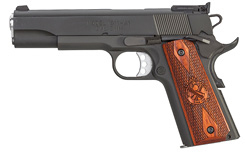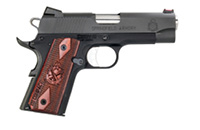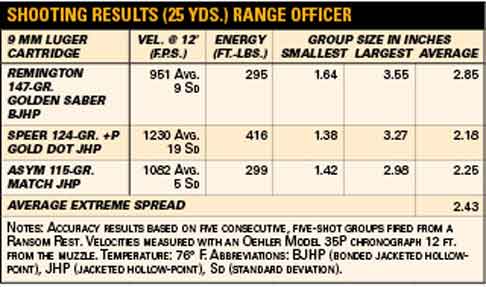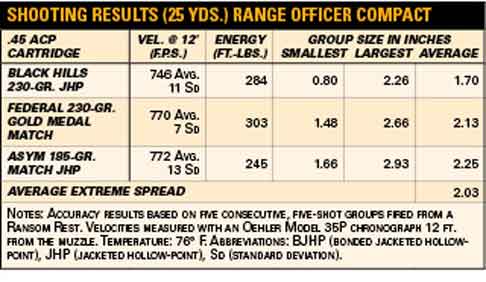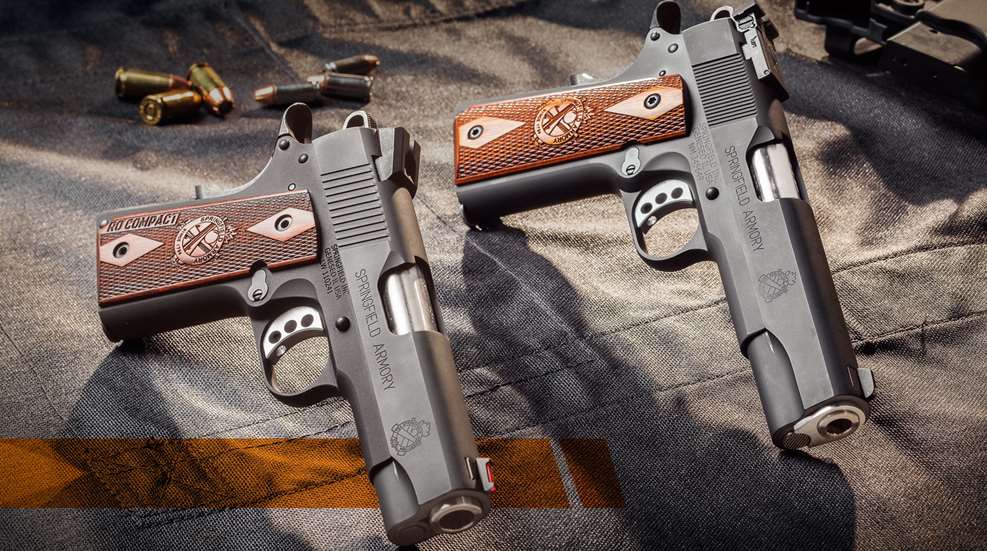
When Americans first loaded a magazine of seven into the hefty butt of a .45-cal. M1911, it was understood that the gun was a military sidearm. Its design was deeply influenced by the needs of the cavalry soldiers who would first be armed with it. It was shorter than the revolvers it replaced, but was, without question, a full-size handgun. The point is simply that it was never viewed as anything but a service pistol, and modifications to make it smaller, lighter or shoot other calibers were way over the horizon.
Well, that was then and this is now. The M1911 is everywhere and in endless variations. It is a military, special operations, police service, competition, concealed carry, home defense and hunting gun. And there are probably other roles I didn’t list. For each, somebody makes an M1911 variant that is optimized for the role. The craftsmen at Springfield Armory in Geneseo, Ill., have been cranking out a wide assortment of new M1911s for decades, so it is not surprising to see a new variation with the company’s crossed cannon logo thereon. This one is called the Range Officer (RO) and it comes in two calibers and two versions.
In a short telephone conversation with Springfield’s Dennis Reese, I got his take on the new model. It’s made for shooters who are making a bold step into the M1911 business for the first time. The ROs are not the most expensive M1911s in the Springfield catalog, an understandably important factor in marketing. Springfield wants to attract shooters who are serious about using the M1911 style of pistol and want a gun with features that will take them a long way into learning the intricacies of shooting it. A high-quality pistol, the RO has the features that are most commonly requested. As it happens, the pistol is a solid platform that would work well for most M1911 jobs. Made in both the original .45 ACP and popular 9 mm Luger chamberings, the RO comes as a full-size, all-steel, 5" pistol, as well as a short-butt, short-slide compact model.
Let’s look at the big gun first. Ours was in 9 mm Luger, currently the most popular center-fire pistol caliber in America. Weighing a full 41 ozs., the big RO seems heavy in hands accustomed to the polymer-butt, steel-slide service pistols that are the norm these days. Those guns weigh in the neighborhood of 30 ozs., so the 9 mm RO is about 25 percent heavier. In .45 caliber, an RO would weigh a bit less, since more metal is removed in making the barrel. There are advantages to weight, but not for habitual carry on the person. When the shooting starts, the all-steel construction comes into its own—the greater weight tends to dampen recoil, as well as being somewhat steadier in the aiming process. To a shooter intent on developing marksmanship and gun-handling skills and willing to fire lots of rounds, the 9 mm RO’s weight means that recoil is not a factor.
Uniformly finished in a dull, tactical black, the RO has the angled cocking serrations found on most current production M1911s. Out front, there’s a dovetailed, square-post front sight with a slightly angled rear face. It matches up with a target-style rear sight, fully adjustable for both windage and elevation. The maker might have installed any number of different sight combinations, but chose to give the RO purchaser plain post and square-notch rear units. The sides of the slide have the typical company markings to include the Springfield Armory logo on the right side. Inside the slide, there is a typical M1911-style barrel with a bushing at the muzzle end. It seems to be rather tightly fitted.
Receiver controls are straight G.I. M1911 type with the exception of a long trigger, insurance pad grip safety and extended safety on the left side only. The mainspring housing is checkered and has the key locking device Springfield developed several years ago. It’s very unobtrusive, but locks the gun up solidly when the provided key is turned. The stocks are particularly nice—double-diamond-checkered hardwood laminate in cocobolo with the company logo laser cut into the sides.
Of course the full-size RO used in this evaluation fires a cartridge that is somewhat shorter than the .45 ACP for which the gun was originally designed. So although making the pistol function with the smaller, shorter 9 mm Luger cartridges had been done before, it had typically involved some kind of trickery to take up the slack in the fore-and-aft dimension of a .45 magazine. The original maker used a spacer in the rear of the magazine. Also, the magazine feed lips needed to be altered to control the top round in the tube. In contrast, the RO 9 mm magazine shows some design ingenuity, with ribs swaged into the flat sides of the tube as well as the rounded front edge. The front edge has a pronounced groove that limits the movement of the cartridges back and forth. It works very well.
All things considered, the RO is a nice rendering of the grand old M1911A1 design, as chambered in a popular cartridge. For most shooters, it is really all the pistol they would ever need. Nonetheless, the shooter who makes the decision to carry concealed is going to have a problem packing this hefty chunk of fightin’ iron. One needs to consider Springfield’s take on the carry gun in the RO line: the RO Compact. It is an abbreviated and modified version of the original Range Officer. And it comes as either a 9 mm Luger or a .45 ACP—my shooting sample was the latter.
It is smaller, shorter, lighter and just plain easier to pack around on your person. Shorter by an inch, the Compact’s barrel does not work by means of a barrel bushing at the front end. The muzzle end of the barrel fits into matching surfaces at the front end of the slide. The recoil spring is on a guide rod that projects slightly forward of the muzzle. This is the same system Springfield has used on shorter M1911 pistols—the Champion series—for a number of years. The result is a shorter pistol, but still long enough for good pointability and a decent sight radius.
In similar fashion, the butt is shorter by a half inch, which reduces magazine capacity by one round. The savings in the height of the pistol may seem small, but it has a beneficial effect in hiding it in a waistband-level belt holster. With a little less butt sticking out and back, there is a little less gun to hide under coat or vest. The receiver is aluminum alloy and, combined with the RO Compact’s reduced dimensions, produces a gun that is 11 ozs. lighter than the big Range Officer. The Compact’s size is about as far away from that of Mr. Browning’s original plan as I would care to go since any further size reduction would invite decreased functional reliability.
Recognizing that this is a small gun for a defensive role, Springfield included a couple of features that are good ideas for a hideout gun. For one thing, the rear sight is an angled, combat-style unit that’s firmly dovetailed in place. It has white dots on either side of the square notch. Down on the front of the slide, there’s one of the increasingly popular fiber-optic sights, with a red aiming element. From the rear, that makes a three-dot sight picture—white-red-white. The RO Compact has the same crisp trigger pull as the RO as well as a fully ramped barrel, extended thumb safety, checkered mainspring housing and long trigger. One final point on the RO Compact—it has the same style of wood laminate stocks as found on the RO; however, they are slimmer, in keeping with the gun’s role as a concealed carry defense gun. All things considered, the Compact is an attractive and businesslike defensive handgun.
At the range, I fired both guns in the Ransom Rest at 25 yds. Using three different commercial loads, I worked my way through five consecutive five-shot groups with each—15 groups with each gun. The results were quite interesting. The 9 mm Luger cartridge has been seldom used as a match cartridge in bullseye-type events. I believe this means a rather small demand for super-accurate 9 mm ammunition. The three loads I selected had 115-, 124- and 147-gr. bullets, the three most popular weights. Measured center spread of those 9 mm groups averaged 2.43". For a service-grade pistol, I consider this to be well above average. Further, if I wanted to use the RO in competition, I would try a much broader range of ammunition or initiate a crusade in handloading to develop a blue-chip load. I am betting this effort would uncover ammo that shot well under the 1.5" mark.
To my considerable surprise, the little RO Compact .45 ACP proved to be an accurate pistol. I used another trio of commercial loads and followed the same protocol. Bullet weights were 230 and 185 grs. The highlight of the shoot was a 0.80" group fired with Black Hills 230-gr. JHPs and the average group size with that load was 1.70". With all three loads, the group size averaged 2.03". This is surprisingly good for a gun engineered around diminished size and weight, then reliability and then accuracy.
Subjectively, the 9 mm RO is a sweetheart to shoot, particularly with the mild load chosen. It has little muzzle rise, making a long match less onerous and distracting. There were two malfunctions with the 9 mm, both of them failures to lock the slide back on firing the last round. I think the magazine was to blame, but it could also be a tightly fitted gun in need of more wearing-in.
It looks like both pistols are viable products in a catalog with many, many options. You can spend more on a Springfield M1911 pistol, but the ROs are very close to being the best buy in the Springfield M1911 line.
Springfield Armory Range Officer
Manufacturer: Springfield, Inc., 420 W. Main St., Geneseo, IL 61254; (800) 680-6866; springfieldarmory.com
Caliber: 9 mm Luger (tested), .45 ACP
Action Type: recoil-operated center-fire semi-automatic pistol
Frame: steel
Barrel: 5"
Rifling: six-groove, 1:16" LH twist
Magazine: detachable box, nine-round capacity (9 mm Luger), seven rounds (.45 ACP)
Sights: fully adjustable rear, ramp front
Trigger Pull: single-action, 4-lb., 7-oz. pull
Overall Length: 8.6"
Width: 1.25"
Height: 5.5"
Weight: 41 ozs.
Accessories: lockable hard case, cable lock, polymer holster and magazine pouch, owner’s manual, two magazines
Suggested Retail: $989
Springfield Armory Range Officer Compact
Manufacturer: Springfield, Inc., 420 W. Main St., Geneseo, IL 61254; (800) 680-6866; springfieldarmory.com
Caliber: 9 mm Luger, .45 ACP (tested)
Action Type: recoil-operated semi-automatic, center-fire pistol
Frame: aluminum alloy
Barrel: 4"
Rifling: six-groove, 1:16" LH twist
Magazine: detachable box, six-round capacity
Sights: fixed combat rear, red fiber-optic front
Trigger Pull: single-action, 4-lb., 8-oz. pull
Overall Length: 7.6"
Width: 1.25"
Height: 5"
Weight: 30 ozs.
Accessories: lockable hard case, cable lock, polymer holster and magazine pouch, bore brush, owner’s manual
Suggested Retail: $977
